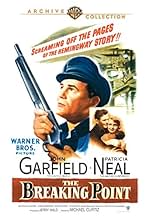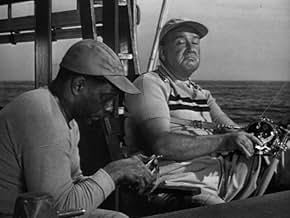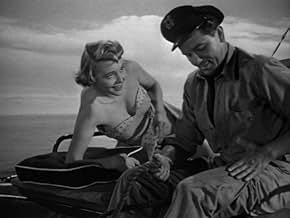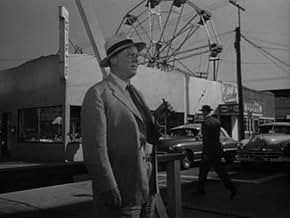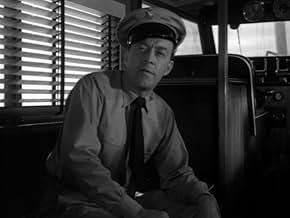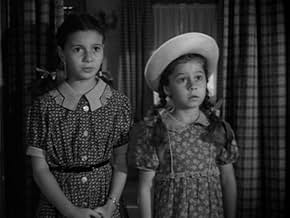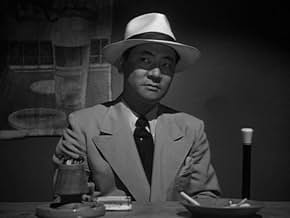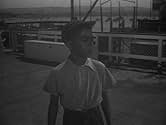IMDb-BEWERTUNG
7,5/10
4878
IHRE BEWERTUNG
Füge eine Handlung in deiner Sprache hinzuAn otherwise moral captain of a charter boat becomes financially strapped and is drawn into illegal activities in order to keep up payments on his boat.An otherwise moral captain of a charter boat becomes financially strapped and is drawn into illegal activities in order to keep up payments on his boat.An otherwise moral captain of a charter boat becomes financially strapped and is drawn into illegal activities in order to keep up payments on his boat.
- Regie
- Drehbuch
- Hauptbesetzung
- Auszeichnungen
- 4 wins total
John Alvin
- Reporter
- (Nicht genannt)
Chet Brandenburg
- Taxi Driver
- (Nicht genannt)
Peter Brocco
- Macho
- (Nicht genannt)
Mary Carroll
- Girl at Bar
- (Nicht genannt)
Spencer Chan
- 1st Chinese Immigrant
- (Nicht genannt)
John Close
- Deputy
- (Nicht genannt)
Empfohlene Bewertungen
No one played the haunted/hunted character better than John Garfield (Humphrey Bogart is a close second). Here, Garfield is a boat captain that gets in way over his head. The thing with Garfield's characters, is that even though the audience sympathizes with his plight, the character always brings it on himself. With Garfield's usual acerbic delivery, his Harry Morgan is hard to like but when he is with his family, one sees that he is basically a headstrong but good guy. Even though Michael Curtiz directed this, the tone and especially the ending shot kept reminding me of Fritz Lang. I think this film should be commended for the ending, which although a somewhat happy one, reminds the audience of the affect of one's actions on everyone. This generally was ignored in a lot of the crime dramas from the 30's to the 60's. My only complaint is the Patricia Neal character seemed tacked on for romance sake. She didn't add much and certainly didn't have an impact on the main thrust of the story. But that is a minor quibble. Another gem for one of the move overlooked actors - John Garfield.
... He is the same guy as always, struggling against odds, railing about making it, etc., but toned down a bit. He takes umbrage but there is a restraint that is not present in his earlier more angry-young-man roles. Maybe because he looks as little filled out and older and is a family man to boot. There is a relative maturity in the character that is appealing. Despite playing the proverbial "same role" as some actors are thought of as doing, there is no sense that he is phoning it in. And he holds up more effective than ever with the ultimate no-nonsense imperative of tough guys. Tough but regular too, I like the opening sally, i.e., to the effect that when out to sea a certain tranquillity can reign but back on land nothing but trouble. I like that, especially with the ultimate irony to come.
The domestic scenes are not Hemingway, but added for the movie. A wonderful decision. It rounds out Garfield's character giving him a softer side and allows for the domestic sweetness and wholesome prettiness of Phyllis Thaxter to be his wife. I like to feel that her all-to-obvious new hairdo was not lost on her husband and that it might have helped him decide on another matter regarding a certain lady.
Garfield's remark to his 10-year-old daughter about being "too old to run around (the house) like that" (i.e., in night clothes) was a surprising but effective slice-of-life detail that perhaps only in a small way ushers in the new 50s sensibility regarding such matters that will make films more frank and real with youth (teens) issues.
Patricia Neal is stunning as the would-be femme fatale, - would-be because she falls short of treachery. Her worldly manner and sophisticated beauty provides a stark contrast to Garfield's women in the story. She wants to seduce, and pending the outcome, have the goods on him for revenge. Is she too sympathetic for this? Up in the air,,pending definitions. Reliable veteran character actor Wallace Ford has a good gig as a low-level conduit to the underworld. He has good dialogue, pushy and sarcastic with his own clients but totally subservient when around the big boys. A happy addition to the story. The poor boy alone on the pier resonates and is discomforting.
The domestic scenes are not Hemingway, but added for the movie. A wonderful decision. It rounds out Garfield's character giving him a softer side and allows for the domestic sweetness and wholesome prettiness of Phyllis Thaxter to be his wife. I like to feel that her all-to-obvious new hairdo was not lost on her husband and that it might have helped him decide on another matter regarding a certain lady.
Garfield's remark to his 10-year-old daughter about being "too old to run around (the house) like that" (i.e., in night clothes) was a surprising but effective slice-of-life detail that perhaps only in a small way ushers in the new 50s sensibility regarding such matters that will make films more frank and real with youth (teens) issues.
Patricia Neal is stunning as the would-be femme fatale, - would-be because she falls short of treachery. Her worldly manner and sophisticated beauty provides a stark contrast to Garfield's women in the story. She wants to seduce, and pending the outcome, have the goods on him for revenge. Is she too sympathetic for this? Up in the air,,pending definitions. Reliable veteran character actor Wallace Ford has a good gig as a low-level conduit to the underworld. He has good dialogue, pushy and sarcastic with his own clients but totally subservient when around the big boys. A happy addition to the story. The poor boy alone on the pier resonates and is discomforting.
An underrated flick in the Garfield canon. His charter boat captain, Morgan, may not be very likable, but the actor makes him a compelling tough guy. So, how's Morgan going to pay his debts and keep his charter boat. It's a struggle, especially when wheedling deal-maker Duncan (Ford) keeps tempting him with illegal transporting. It's really a battle for Morgan's soul though he doesn't realize it. On one hand there's faithful wife Lucy (Thaxter) and two small daughters, along with deck hand Park (Hernandez) depending on him for support. On the other, is smoothy Duncan, sultry temptress Leona (Neal), and an array of criminal types offering him money for illegal services. Trouble is Morgan loves both Lucy and his boat, so will he stay honest and get a new livelihood, or will he succumb to seductive overtures from Duncan and turn criminal boat captain.
Garfield's Morgan is not a nice guy, so the outcome is uncertain. Every other word is a smart-alecky remark, and though he loves wife Lucy and the two little girls, he seems to forget them when obsessing about his boat. Clearly, his ego is tied up with being a captain.
It's a perfect Garfield role, and he gives no quarter. At the same time, Thaxter works wonders as the sympathetic wife without getting smarmy, a really difficult role. And shouldn't overlook Neal whose grinning blonde temptress resembles a figure from perhaps the lower regions. Then too, inclusion of Black actor Hernandez was a bold one for 1950 when Black actors were still mostly servants or comic relief. Moreover, his inclusion results indirectly in one of the most brilliantly poignant final scenes in film annals. I get the feeling the writers were doing their best to avoid a typical Hollywood ending, which was still the norm.
All in all, the movie deserves a ranking just below Garfield's celebrated Force of Evil (1948) as a study in self-realization. Please, TCM, revive the flick whenever you can.
Garfield's Morgan is not a nice guy, so the outcome is uncertain. Every other word is a smart-alecky remark, and though he loves wife Lucy and the two little girls, he seems to forget them when obsessing about his boat. Clearly, his ego is tied up with being a captain.
It's a perfect Garfield role, and he gives no quarter. At the same time, Thaxter works wonders as the sympathetic wife without getting smarmy, a really difficult role. And shouldn't overlook Neal whose grinning blonde temptress resembles a figure from perhaps the lower regions. Then too, inclusion of Black actor Hernandez was a bold one for 1950 when Black actors were still mostly servants or comic relief. Moreover, his inclusion results indirectly in one of the most brilliantly poignant final scenes in film annals. I get the feeling the writers were doing their best to avoid a typical Hollywood ending, which was still the norm.
All in all, the movie deserves a ranking just below Garfield's celebrated Force of Evil (1948) as a study in self-realization. Please, TCM, revive the flick whenever you can.
The Breaking Point cannot properly be called a remake of To Have And Have Not as that classic film was altered to make the story relevant for domestic consumption in wartime America. There was also added the legendary chemistry of Bogey and Bacall in their first film together. Ernest Hemingway did not write that for the movie-going public.
The Breaking Point is far more Hemingway and far more realistically done. John Garfield makes a perfect Hemingway hero and the locations along the California coast aren't glamorized in any way. This is a working class locale and the black and white cinematography and wind swept look given by same reflects Garfield and the area he is raising his family in.
Garfield plays a World War II veteran who wanted to earn a living on the sea and have Phyllis Thaxter raise their daughters in that coastal location. But business comes in cycles and a bad season finds Garfield owing everyone including the butcher, the baker and candlestick maker. Most of all he owes for fuel and that guy is ready to take the boat for payment.
When a charter client stiffs him on the bill, Garfield is forced to make some bad choices to pay his bills and support his family. Providing some of those bad choices is Wallace Ford playing a truly sleazebag shyster living on the Mexican side of the Pacific coast who ostensibly will get you a quickie Mexican divorce, but dabbles in all kinds of illegal fields. Actually I'm being unfair, shysters make bad lawyer jokes about Ford.
Providing a little temptation for Garfield is Patricia Neal who is trying very hard for the same Lauren Bacall effect. She's the girlfriend of the client who stiffed Garfield in the first place and she has most original and cynical point of view about life and men.
The Breaking Point provides John Garfield with one of his best performances in his next to last film. And he far more fits the Hemingway conception as does the overall film itself.
The Breaking Point is far more Hemingway and far more realistically done. John Garfield makes a perfect Hemingway hero and the locations along the California coast aren't glamorized in any way. This is a working class locale and the black and white cinematography and wind swept look given by same reflects Garfield and the area he is raising his family in.
Garfield plays a World War II veteran who wanted to earn a living on the sea and have Phyllis Thaxter raise their daughters in that coastal location. But business comes in cycles and a bad season finds Garfield owing everyone including the butcher, the baker and candlestick maker. Most of all he owes for fuel and that guy is ready to take the boat for payment.
When a charter client stiffs him on the bill, Garfield is forced to make some bad choices to pay his bills and support his family. Providing some of those bad choices is Wallace Ford playing a truly sleazebag shyster living on the Mexican side of the Pacific coast who ostensibly will get you a quickie Mexican divorce, but dabbles in all kinds of illegal fields. Actually I'm being unfair, shysters make bad lawyer jokes about Ford.
Providing a little temptation for Garfield is Patricia Neal who is trying very hard for the same Lauren Bacall effect. She's the girlfriend of the client who stiffed Garfield in the first place and she has most original and cynical point of view about life and men.
The Breaking Point provides John Garfield with one of his best performances in his next to last film. And he far more fits the Hemingway conception as does the overall film itself.
This is a remake of TO HAVE AND HAVE NOT that supposedly from what I've read sticks closer to the Hemingway story. Garfield could play the strong but tormented guy like nobody's business, here however we have most of the information needed in understanding just what's eating at this guy, wearing him down and making him afraid. "A man alone hasn't got a chance," he keeps repeating. But Harry isn't alone. He's got a family that loves him, a plain but good woman he adores, and who adores him. A best friend who is his shipping mate, yet he still can't shake the feeling that somehow the universe is against him, working overtime. He's like a man that needs some spiritual guidance. Something is missing. On first viewing this plays like a well done yarn. On subsequent viewings however, this film begins to haunt. The characters and scenes play on a deeper, more meaningful level. The domestic scenes, usually the throwaway, boring parts of a story like this, become the rock and Garfield and Phylis Thaxter emit genuine emotion and affection for one another that is unusually realistic. Patricia Neal is the temptress here, and in an unusual move, we're not supposed to fall in love with her or maybe even like her, which is evident in how she's physically presented. Her haircut is really bad and she's basically unflatteringly lit and photographed. She too looks realistic: like a once beautiful creature who's been around the block too many times and is starting to look all used up.
Juano Hernandez rounds out the main players as Garfield's friend and shipmate. It was Garfield who insisted the character be a black man and had the relationship between the two beefed up. According to Garfield's daughter, the studio didn't like the idea and tried to talk him out of it, eventually giving up. This casting led to someone (director Michael Curtiz?)coming up with that final shot in the film that hits like a sucker punch to the gut, unexpected and unforgettable.
Watch this one a second time and see if you agree.
Juano Hernandez rounds out the main players as Garfield's friend and shipmate. It was Garfield who insisted the character be a black man and had the relationship between the two beefed up. According to Garfield's daughter, the studio didn't like the idea and tried to talk him out of it, eventually giving up. This casting led to someone (director Michael Curtiz?)coming up with that final shot in the film that hits like a sucker punch to the gut, unexpected and unforgettable.
Watch this one a second time and see if you agree.
Wusstest du schon
- WissenswertesAccording to TCM's Eddie Muller, John Garfield thought this was his best performance and that it was the film of which he was most proud.
- PatzerWhen she first steps onto the boat, Patricia Neal's voice is heard saying "we're off to sunny Mexico," but her lips aren't moving.
- Zitate
Harry Morgan: You know, my wife dyed her hair.
Leona Charles: Coincidentally I've been thinking of letting mine grow out. Speaking of coincidences, I live in Number Seven. My friends just kick the door open.
- Crazy CreditsTHE END close out. All lettering aligned and centered except for the line beneath Warner Bros. that begins PICTURES. It's left registered with whatever wording that followed it 'air brushed' over using the lower right drop shadow pattern leaving a Warner Bros. Pictures _?_?_?_?_ mystery.
- VerbindungenFeatured in The John Garfield Story (2003)
- SoundtracksPlease Don't Talk About Me When I'm Gone
(uncredited)
Music by Sam H. Stept
Lyrics by Sidney Clare
Sung by Patricia Neal in the bar
Top-Auswahl
Melde dich zum Bewerten an und greife auf die Watchlist für personalisierte Empfehlungen zu.
- How long is The Breaking Point?Powered by Alexa
Details
- Laufzeit1 Stunde 37 Minuten
- Farbe
- Seitenverhältnis
- 1.33 : 1
Zu dieser Seite beitragen
Bearbeitung vorschlagen oder fehlenden Inhalt hinzufügen

Oberste Lücke
By what name was Menschenschmuggel (1950) officially released in India in English?
Antwort


